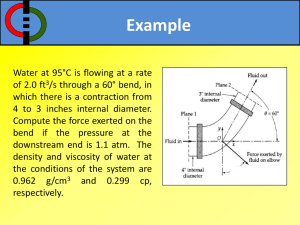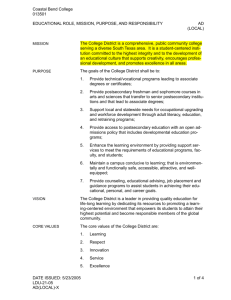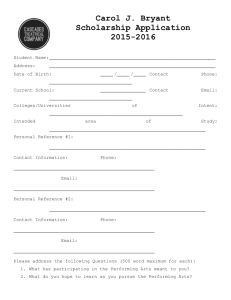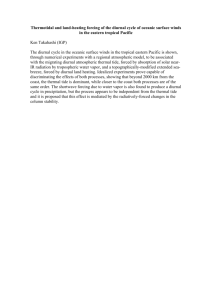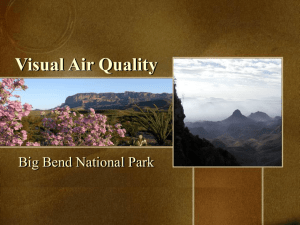Final Report Project Title: Characterization of Atmospheric
advertisement
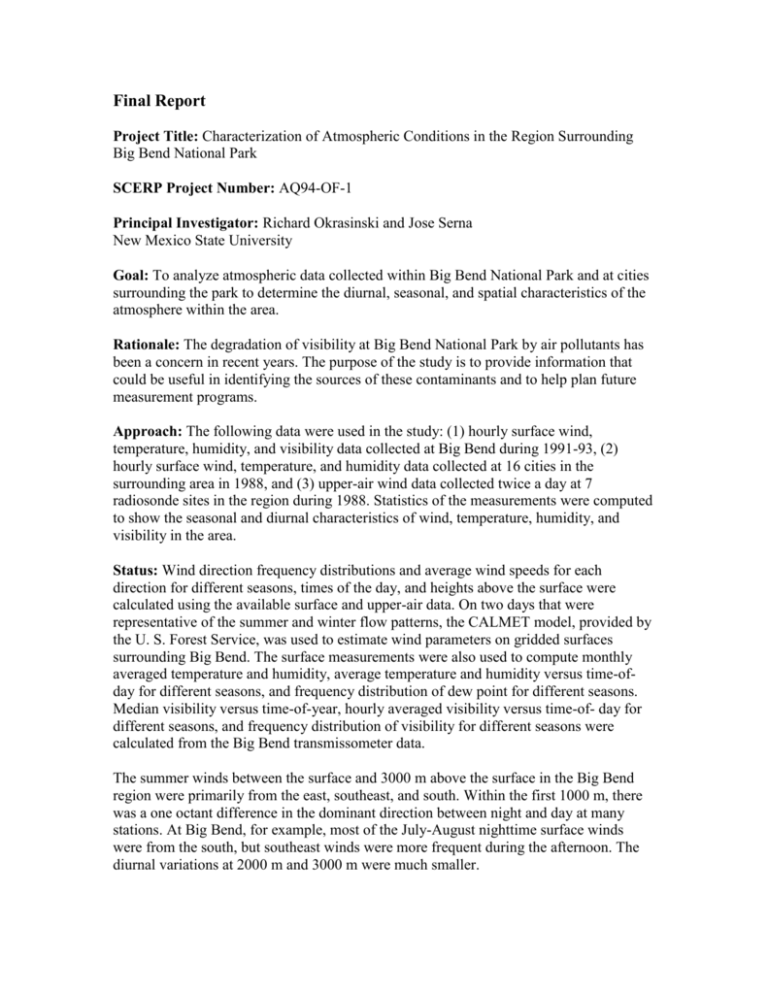
Final Report Project Title: Characterization of Atmospheric Conditions in the Region Surrounding Big Bend National Park SCERP Project Number: AQ94-OF-1 Principal Investigator: Richard Okrasinski and Jose Serna New Mexico State University Goal: To analyze atmospheric data collected within Big Bend National Park and at cities surrounding the park to determine the diurnal, seasonal, and spatial characteristics of the atmosphere within the area. Rationale: The degradation of visibility at Big Bend National Park by air pollutants has been a concern in recent years. The purpose of the study is to provide information that could be useful in identifying the sources of these contaminants and to help plan future measurement programs. Approach: The following data were used in the study: (1) hourly surface wind, temperature, humidity, and visibility data collected at Big Bend during 1991-93, (2) hourly surface wind, temperature, and humidity data collected at 16 cities in the surrounding area in 1988, and (3) upper-air wind data collected twice a day at 7 radiosonde sites in the region during 1988. Statistics of the measurements were computed to show the seasonal and diurnal characteristics of wind, temperature, humidity, and visibility in the area. Status: Wind direction frequency distributions and average wind speeds for each direction for different seasons, times of the day, and heights above the surface were calculated using the available surface and upper-air data. On two days that were representative of the summer and winter flow patterns, the CALMET model, provided by the U. S. Forest Service, was used to estimate wind parameters on gridded surfaces surrounding Big Bend. The surface measurements were also used to compute monthly averaged temperature and humidity, average temperature and humidity versus time-ofday for different seasons, and frequency distribution of dew point for different seasons. Median visibility versus time-of-year, hourly averaged visibility versus time-of- day for different seasons, and frequency distribution of visibility for different seasons were calculated from the Big Bend transmissometer data. The summer winds between the surface and 3000 m above the surface in the Big Bend region were primarily from the east, southeast, and south. Within the first 1000 m, there was a one octant difference in the dominant direction between night and day at many stations. At Big Bend, for example, most of the July-August nighttime surface winds were from the south, but southeast winds were more frequent during the afternoon. The diurnal variations at 2000 m and 3000 m were much smaller. The frequency of this easterly and southerly flow decreased in the winter and was replaced with northerly and northwesterly flow near the surface and southwesterly, westerly, and northwesterly flow aloft. The summer flow was still common at the surface and at 1000 m, however, especially at the more southern stations. At 2000 m and 3000 m, almost all the winter winds were from the southwest, west, or northwest. Large diurnal differences in the winter surface wind direction patterns were found at some stations, but the variations at 1000 m and above were very small. The spring and fall wind direction frequencies were intermediate between the summer and winter frequencies. The temperatures and dew points measured at Big Bend were similar to those measured at El Paso and other arid western stations. Visibility at Big Bend was best in January and poorest in late summer. There was also a significant diurnal variation. Poorest visibilities were in the early morning before dawn, and best visibilities were in the late afternoon. Practical Use:In future measurement programs, upper-air data provided by the rawinsondes should be supplemented by data from other sensors such as Doppler sodars and LDVs that measure atmospheric boundary layer parameters with greater temporal and spatial resolution. Any measurement plan should also consider the significant diurnal variations in visibility and other atmospheric parameters at Big Bend. Finally, the sensors should be situated around Big Bend to correspond to the most common wind directions. References used in preparing this report Douglas S. and R. Kessler, User's Guide to the Diagnostic Wind Field Model (Version 1.0), Systems Applications, Inc., San Rafael, CA, 1988. Pitchford M. L. and W. C. Malm, "Development and Applications of a Standard Visual Index", Atmos. Env, 28(5), pp. 1049-1054, 1994. Sisler J. F., D. Huffman, and D. A. Latimer, Spatial and Temporal Patterns and the Chemical Composition of the Haze in the United States: An Analysis of Data from the IMPROVE Network, 1988-91, ISSN 0737-5352-26, Colorado State University, Fort Collins, CO 80523, 1993.
